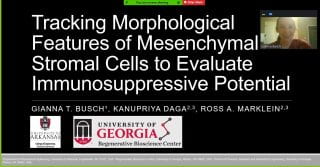Busch Internship Experience
 As a junior biomedical engineering student, I had already been working in Dr. Kyle Quinn’s lab for two semesters and had participated in a summer research program at the Vanderbilt Biophotonics Center. My passion for biomedical engineering research was already strong, and as such, I was looking forward to participating in another research program during the summer of 2020. I applied to several programs and was accepted to an REU at the University of Georgia. Dr. Ross Marklein reached out to me the day after I received the acceptance email. We had an excellent Skype call where we discussed the work his lab was doing and the potential projects he had available for summer students. After the call, he offered me a position in his lab through the program if I accepted the offer, which I immediately did. At this point I was already ecstatic at the prospect of working in his lab and applying the imaging techniques I had learned in Dr. Quinn’s lab to different problems, as well as exploring UGA’s campus.
As a junior biomedical engineering student, I had already been working in Dr. Kyle Quinn’s lab for two semesters and had participated in a summer research program at the Vanderbilt Biophotonics Center. My passion for biomedical engineering research was already strong, and as such, I was looking forward to participating in another research program during the summer of 2020. I applied to several programs and was accepted to an REU at the University of Georgia. Dr. Ross Marklein reached out to me the day after I received the acceptance email. We had an excellent Skype call where we discussed the work his lab was doing and the potential projects he had available for summer students. After the call, he offered me a position in his lab through the program if I accepted the offer, which I immediately did. At this point I was already ecstatic at the prospect of working in his lab and applying the imaging techniques I had learned in Dr. Quinn’s lab to different problems, as well as exploring UGA’s campus.
However, a week later the University of Arkansas cancelled classes for the remainder of the Spring 2020 semester due to COVID-19. Many other colleges were following suit and I wasn’t sure what to expect from my REU program. It was a tense few weeks waiting to hear what would happen, but throughout, Dr. Marklein was very supportive and reassuring. Eventually, the program announced that we would be participating virtually. Although I was looking forward to participating in person, I was happy that at least the REU had not been cancelled outright like so many other programs.
Dr. Marklein’s lab focuses on developing innovative approaches incorporating high-throughput, therapeutically relevant single cell profiling to assess cellular heterogeneity and accelerate translation of mesenchymal stromal cell (MSC) therapies. MSCs have significant potential to modulate the immune system and therefore, treat immune disorders such as multiple sclerosis and graft-versus-host disease. Despite promising preclinical data, clinical success has been elusive, potentially due to the inherent heterogeneity of MSCs. Although this heterogeneity is widely recognized, it is not yet well understood. In addition to the heterogeneity found in individual populations, it can also arise from differences in donor source and manufacturing conditions.
My summer project in Dr. Marklein’s lab was part of a larger effort to use functionally-relevant morphological profiling to evaluate morphological features of MSCs as potential critical quality attributes (CQAs) of immunosuppressive potential. Previous work on this project involved stimulating MSCs with interferon-gamma (IFN-γ), an inflammatory cytokine, before fixing and imaging a plate of cells every 15 minutes for 24 hours. The fixed-phase imaging data showed that distinct subpopulations did arise. However, the live phase imaging data from this study had never been analyzed. This provided the perfect project for me to be able to complete remotely while still developing new skills and learning more about a different field of biomedical engineering. I used CellProfiler to develop a pipeline which was able to track and quantify the morphological features of cells at each timepoint over the 24-hour period. I found that the live phase imaging data showed evidence of potential dynamic subpopulations emerging over the course of the study and that this approach could be generalized to other adherent cells responding to a functionally-relevant stimulus. I presented this work at the REU’s end-of-summer virtual symposium, which I also co-chaired. In addition, I gave a poster presentation at the 2020 BMES Annual Meeting over this work entitled “Tracking Morphological Features of Mesenchymal Stromal Cells to Evaluate Immunosuppressive Potential.”
As I have been going through the process of applying to graduate schools, I have kept in mind a piece of advice that I received: “Don’t think about where you want to be when everything is going well; think about where you would want to be when everything is going terribly.” Although this summer was not what I expected, Dr. Mao, Dr. Marklein, and everyone else who helped put the program together did their absolute best to make the REU as positive and enjoyable for us as possible. It was an incredibly valuable experience and I gained a lot from my participation in it. I was able to develop new technical skills and learn more about a field of biomedical engineering with which I was not yet familiar. Some programs simply weren’t able to transition to virtual delivery, but it was very reassuring to see how supportive and flexible the NanoBio REU faculty, staff, and graduate students were through the entire process. I encourage any undergraduate biomedical engineering students to apply to the 2021 NanoBio REU program (which is currently planned for in-person participation!) and the other excellent REU opportunities for biomedical engineers at the University of Georgia.
Please reach out to me if you have any questions about the program!
